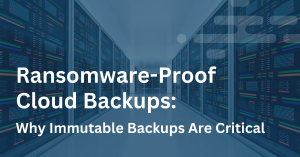Disaster recovery testing is like a dress rehearsal for the big show – it’s meant to prepare you for the worst-case scenario. But what happens when the performance doesn’t quite match the practice? Many businesses find themselves grappling with this very question, realizing that there are gaps between their testing efforts and the actual experience of surviving a real disaster.
Closing this gap has become more critical than ever. It’s not just about ticking boxes or meeting compliance requirements; it’s about ensuring that when disaster strikes, your organization is not just ready to respond, but resilient enough to bounce back stronger than before.
Let’s look at the nitty-gritty of disaster recovery testing and the strategies you can employ to bridge the gap between practice runs and the real deal.
The Current Disaster Recovery Landscape
The disaster recovery landscape in 2023 saw businesses embrace a number of key trends and best practices to maintain business continuity during disruptions and downtime. These factors are continuing to influence the IT disaster recovery landscape in 2024 and include:
- Cloud-based Disaster Recovery: By now, most businesses have adopted cloud solutions, including cloud-based disaster recovery that brought with it scalability, agility, and cost-effectiveness. With this, disaster recovery-as-a-service (DRaaS) is becoming more and more popular.
- Cybersecurity Focus: Given the increase in cyber threats, cybersecurity is a heightened focus within disaster recovery plans. This involves incorporating ransomware recovery, data encryption, multi-factor authentication, and regular vulnerability assessments into disaster recovery strategies.
- AI and Machine Learning: AI and machine learning are being integrated into disaster recovery planning to boost threat visibility and predictive analytics to monitor and detect anomalies that can signal ransomware attacks.
Even with these advancements, organizations still need help with the complexity of disaster recovery preparedness and closing the gap between a plan that looks good on paper and one that will withstand disruptions, downtime and ransomware attacks. This makes it difficult to identify and address potential issues and decreases the chances of successfully recovering from a disaster in real life
Some Key Statistics You Should Be Aware Of
For now, we’ll limit our discussion of disaster recovery to a single cause of disruptions and downtime: ransomware. Although ransomware is only one of many potential reasons why businesses experience disruptions and downtime, the number of highly publicized attacks makes it an easy option to examine and quantify.
1. “Companies suffer almost daily from ransomware attacks.”

Ransomware attacks are a significant threat to businesses, with many companies experiencing attacks on a regular basis. The frequency of ransomware attacks is alarming, with statistics showing that successful ransomware attacks occur every 40 seconds.
2. “Only 57% of businesses are somewhat successful in recovering their data using a backup.”
This statistic highlights the importance of having a backup plan in place. But more importantly, it shows that you should not rely solely on cloud-based backups as a redundant solution to ransomware attacks. Backups alone cannot guarantee a smooth recovery process as they can be damaged, untested, or encrypted by attackers.

3. “Ransomware attacks usually target mission-critical institutions and organizations, such as healthcare, finance, manufacturing, and government organizations.”

These sectors are often prime targets due to the sensitive nature of their operations and the potential for significant financial gain for attackers. Case in point: the Syracuse City School District and the New York City Public Schools breach, which exposed sensitive information of students and staff, as well as the ransomware attack on Suffolk County, which disabled critical computer systems, including 911 dispatch and Department of Motor Vehicles systems.
4. “Very few businesses include a separate ransomware recovery plan as part of their disaster recovery strategy.”
When businesses don’t prioritize planning for ransomware recovery, it leaves them vulnerable and unprepared to deal with ransomware attacks. These attacks are different from other types of disasters or cyber threats, so it’s important to have a specific plan in place to respond effectively. Recognizing this need for a focused ransomware recovery plan is crucial for businesses to minimize the damage caused by these increasingly common and harmful cyber threats.

The above statistics highlight two main points: First, organizations of every size, location, and kind are vulnerable to attacks and at risk of experiencing extended downtime. Second, the effects of that downtime hit hard on multiple fronts.
How to Identify Gaps in Disaster Recovery Plans
To close the gap between disaster recovery testing and surviving a real disaster, you must first identify the gaps in your existing disaster recovery strategy. The most common gaps in disaster recovery plans include:
- Lack of Focus on Continuity: Some organizations prioritize recovery over continuity, focusing on restoring the current environment rather than ensuring business functions remain operational during disruptions.
- Shrinking Recovery Windows: With the increasing need for always-on workloads, recovery windows have become shorter, requiring more advanced methods to protect business functions.
- Data Growth: The exponential increase in data has led to longer backup and restore times, necessitating creative solutions to address recovery needs.
- Relying on a Single Vendor/Strategy: Over-reliance on a single vendor or strategy can lead to a single point of failure, making it essential to have redundancy in vendors and strategies.
- Forgetting About Your Network: You cannot have true disaster recovery without network recovery that protects your entire LAN/WAN with minimal business impact during failover and recovery.
- Lack of Ransomware Protection Plan: Every disaster recovery plan should be about preventing ransomware attacks before they happen.
We’re sure you already know the basics of addressing these gaps: identify potential risks, review your current disaster recovery strategy, update it regularly, set RTOs and RPOs, and the big one – test your plan. These tests should include:
- Parallel Testing: Build and use recovery systems identical to production systems, running them in parallel with the production environment. This provides deeper insight into any changes needed in the backup systems.
- Full-interruption Testing: Use real production data and equipment to respond to a fabricated disaster. This is the most disruptive test, but it provides the most realistic scenario. It includes thoroughly examining all functional areas within the organization to pinpoint potential issues such as data loss or leakage and testing your strategy in unpredictable, inconvenient environments.
- What-if Scenarios: Lay out specific disaster scenarios and ask each team member what they would do. This may reveal gaps in the plan that can be addressed before they cause a DR failure. This is best tested with select team members and testing for unplanned scenarios.
- Use Automation: Automated testing solutions can help support disaster recovery testing needs, ensuring that tests are thorough and rigorous.
When you understand where the gaps in your current protection lie, you can first build a disaster recovery strategy that includes a ransomware recovery plan and then start performing disaster recovery testing that closely mimics the actual conditions that your business will face during a real crisis. Regular testing will ensure that your disaster recovery plan works as intended and that you can remain operational if a disaster strikes.
Final Thoughts
The old saying goes that the best time to prepare for a storm is before the storm hits; the next best time is now. Disaster recovery planning in 2024 demands a dynamic and forward-thinking approach.
Aligning testing efforts with real-world resilience cannot be overstated. As we’ve explored the intricacies of disaster recovery testing and the strategies to bridge the gap between simulations and actual disasters, it’s evident that proactive measures are key to overcoming challenges.
The main goal here is not to treat your recovery testing as a pass/fail exercise, as you’ll miss a golden opportunity to use it to improve overall organizational resilience. Taking a holistic approach to your disaster recovery strategy and closing the gaps mentioned above increases your chances of a successful recovery in the event of a real disaster.
While businesses have embraced trends like cloud-based solutions, cybersecurity enhancements, and AI integration, the threat of ransomware remains a pressing concern. The statistics underscore the severity of ransomware attacks and the imperative need for tailored recovery plans.






